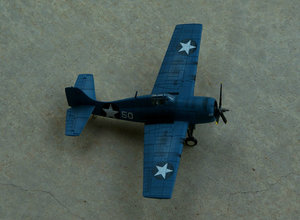Advertisement
Published: July 13th 2013

 JOE FOSS
JOE FOSS
The photo shows a diecast model in 48 scale of one of the planes Joe Foss flew in the Cactus Air Force. Pappy Boyington was also a contender for top Marine Ace. Pappy is credited with 24 aerial victories as a Marine pilot. plus 3.5 more a member of the Flying Tigers. Pappy was also awarded the Medal of Honor, but he was a surly drunk who had antagonized every commanding officer. I met Pappy at book signing in 1976 and he was still a surly drunk. Helluva pilot though.JOE FOSS
Joe earned his wings through the aviation cadet program in the Marine Corps. He wanted to be a fighter pilot but in 1941, at the ripe age of 26, was considered to be too old for combat duty. He was assigned to a photo recon squadron but as combat losses began to toll up during the spring of 1942 the age restriction was set aside. By June of 1942 Joe found himself assigned to VMF- 121 and was flitting around the sky at the stick of a Grumann F4F-4 Wildcat. The Wildcat was brought into the service of the Navy as a replacement fighter to the Brewster2A. It was a capable fighter with 6 wing-mounted 50 caliber machine guns. It was a bit slower than a Jap Zero and could not climb as fast or turn as sharply and could not fly as far, but it had self-sealing fuel tanks, armor protection for the pilot and was stoutly built. It could take plenty of abuse and was hard to shoot down. Effective combat tactics were developed for the Wildcat that gave it a 6:1 kill ratio over the Zero by 1943 when the Wildcat was phased out to the F6F Hellcat. Early in the war the Wildcat was what the Navy had, and what the Navy had the Marines also got. They made good use of that plane. In August of 1942 Operation Watchtower began and the Battle of Guadalcanal was being hotly contested. The Japs had built an airstrip there that had the potential of controlling vital supply approaches to Australia. On the other side of the coin we wanted the airstrip to launch attacks against the Jap stronghold at Rabaul. Guadalcanal had important strategic value to both sides. Those who planned the Guadalcanal Campaign called it Operation Watchtower, and had given the island a code name of Cactus. After a particularly vicious stretch of fighting the Marines took the airfield and drove the Japs back into the jungle. The airstrip was renamed Henderson Field after a pilot killed during the Battle of Midway. Planes that flew out of Henderson came to be known as the Cactus Air Force. VMF-223 arrived at Henderson Field first and they set about defending the airstrip and saw plenty of hot action every day. When the Japs lost the airfield it became more difficult for them to supply their soldiers. Anything they got had to come in by boat. The increased sea traffic brought on two major naval battles nearby. One was in the East Solomon Sea and the other was north of Santa Cruz Island. We lost the Hornet at Santa Cruz. It was the ship that launched the Doolittle Raid back in April. The engagements at sea were costly and by December the Japs had been forced to abandon their efforts at Guadalcanal. In the meantime the Cactus Air Force fought steadily on through incredibly grueling circumstances. On October 12 what was left of the battered VMF-223 was pulled out of the Guadalcanal Campaign and replaced with VMF-121. The very next day Joe Foss scored his first aerial victory over a Jap Zero. By the time the campaign ended in December Joe had scored 26 combat victories. He was awarded the Congressional Medal of Honor and made in to a national celebrity. By war’s end he was still the leading Marine ace. After the war he operated an air service and flight school and then entered politics. He was the youngest ever Governor of South Dakota and then a U S Congressman. He was defeated in a run for a seat in the Senate by another war hero named George McGovern. In due course Joe became the first commissioner of the American Football League, which he helped to get started. He had a national TV show called America Outdoors. It was a hunting and fishing show that aired for several seasons. By 1988 he was President of the National Rifle Association. What he is perhaps best known for in Arizona is being rousted by airport security at Sky Harbor Airport in December of 2001. They wanted to confiscate and destroy his Medal of Honor and a toenail clipper that had an MOH emblem.
Advertisement
Tot: 0.106s; Tpl: 0.01s; cc: 16; qc: 29; dbt: 0.0634s; 1; m:domysql w:travelblog (10.17.0.13); sld: 1;
; mem: 1mb

 JOE FOSS
JOE FOSS